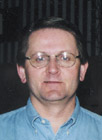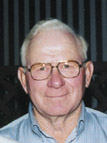|
The Next 25 Years and Beyond By Lois Kerr
Tom Rolfstad, director of Williston Economic Development, along with Russ Fullmer, Sidney Holly Sugar ag manager, Don Steinbeisser, long-time area beet grower, and Joyce Eckhoff, agronomist at the Eastern Ag Research Center, recently speculated on what the next 25 years and beyond may bring to the Sidney area. All four of these experts in their chosen fields agreed: change will continue to occur, change is necessary for growth and we as a region must take the initiative in directing these changes. Russ Fullmer believes the Sidney factory itself will see many changes by the time the plant celebrates its 100th anniversary. "We as an industry will have the problems solved with sugar prices," Fullmer speculates. "The Sidney factory will be a larger factory than it is today, as our expansion will continue. The smaller factories in the U.S. will close out, but larger factories will expand and increase in acres." Steinbeisser agrees. "This factory will process beets well into the future," he asserts. All of the futuristic experts agree that the sugar industry will consolidate, and that Sidney will become more important. "There may be only five or six factories that process sugar in the U.S., but they will be large factories, encompass a lot of acres, and Sidney will be one of those plants," Fullmer states. Steinbeisser and Fullmer believe that beet quality and tonnage will continue to increase. "There's no limit," Fullmer points out. "With breeding and genetics, the sky is the limit. Quality will have to continue to improve so we can stay competitive. I also see growers becoming more and more involved with value added crops, not only in the sugar industry, but in all of agriculture. Growers will control their own product. This trend has started, and it will continue to increase." Besides changes in the sugar industry and the factory, the foursome sees changes ahead for growers, in irrigation methods and in genetic engineering. Steinbeisser believes grower acreage will continue to increase, along with improved technology applications. "Cars of the '50s look old to us today," he observes. "The new farming equipment we have today will look ancient compared to the equipment we'll see 25 years from now." Eckhoff believes that the equipment growers use in the future will not operate on diesel or petroleum products. "We won't rely on petroleum products much at all," she notes. "We'll be using solar or wind power. If we are still using combustion engines at all, the fuel will come from vegetable oils, such as safflower and sunflower oils, not from petroleum products." Steinbeisser and Eckhoff believe the use of computers in precision agriculture will continue to escalate. Steinbeisser says, "We'll rely on global positioning satellites to seed and to fertilize our fields. Satellite photography will allow us to estimate our crop yields, and apply spray and fertilizers only where they are needed within each field." Eckhoff takes the global positioning systems one step further. "The tractor computers will link directly into the satellites," she states. "Mapping fields will be outdated. The computers on the tractors will communicate directly with the satellites, and producers will deliver seed, fertilizers and pesticides as needed according to the direct link satellite information." All four experts believe that the public will eventually accept genetic engineering. "This technology can't be bottled up," Fullmer observes. "Sooner or later, the practice of genetic engineering will gain acceptance and will solve many problems facing us today." "Genetic engineering will help solve disease problems and assist in rotations," Rolfstad states. Eckhoff adds, "Pesticides won't be used much, if at all. Genetic engineering will no longer be frowned upon, and not only will crops be genetically improved, but we'll also have friendly bacteria to protect crops from insect pests." The foursome also believes the area will attract and have several processing plants, including potato processing, cheese processing and vegetable processing. The region will also have many dairies. "This area could become a vegetable center," Rolfstad remarks. "We'll have three or four good crops for rotations. We'll have a lot of options as other areas of the country get closed in." Fullmer envisions a host of dairies scattered throughout the Yellowstone Valley. "The traditional dairy areas are becoming increasingly populated," he notes. "Those dairy operations will move to this area." He laughs and adds, "We'll have our own major cheese processing facility here, and who knows? We may have a great reputation for our own specialty brand of world famous Yellowstone Valley cheese." Rolfstad sees economic and population pressures in other parts of the country raising interest in agriculture in this region. "We have the climate, the water and good soils," he remarks. "However, you won't see flood irrigation here in 25 years. Efficiency, labor costs and environmental issues will all work to phase out flood irrigation. We'll use some variation of center pivots for irrigation." Eckhoff agrees, and adds, "Not only will tractor computers be hooked directly to satellites, but so will sprinkler systems, with the ability to deliver water when and where needed." She continues, "We'll have improved irrigation systems with no runoff, no seepage, no leaching and no waste. We'll move beyond pivots, to some sort of system that puts the water directly at the roots, where it is needed." The foursome conclude their futuristic scenarios with agreement that the MonDak region is a strong, healthy area, with great potential and a bright future. "The more things change, the more they remain the same," Rolfstad comments. Fullmer adds, "We need to work together to promote growth and to invest in the future. If we work together, we can create our own future." |



